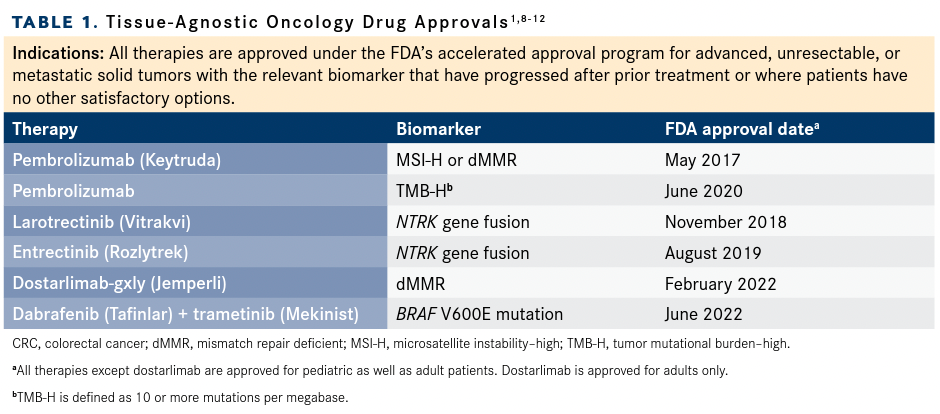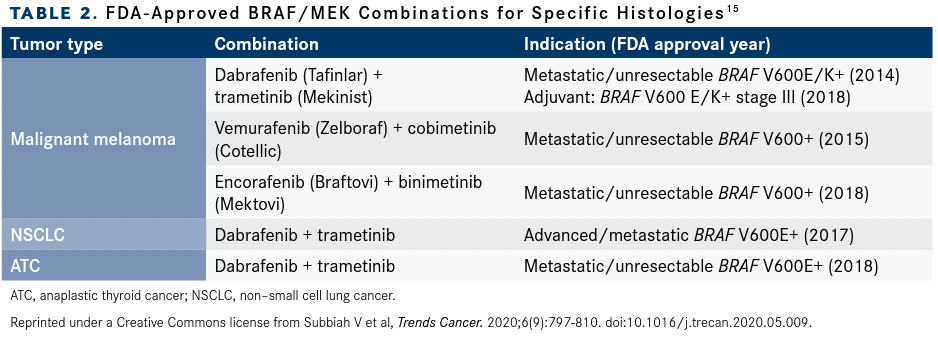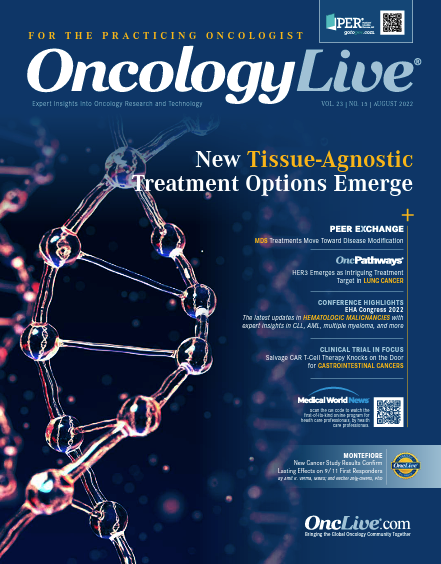Publication
Article
New Tissue-Agnostic Treatment Options Emerge
Author(s):
The menu of tissue-agnostic oncology drug approvals is growing, generating new treatment options for patients with rare cancers and strengthening the rationale for broad next-generation sequencing.
Vivek Subbiah, MD

The menu of tissue-agnostic oncology drug approvals is growing, generating new treatment options for patients with rare cancers and strengthening the rationale for broad next-generation sequencing (NGS), experts say.
In June 2022, the FDA approved the combination of dabrafenib (Tafinlar) plus trametinib (Mekinist) for patients with metastatic solid tumors with BRAF V600E mutations, marking the fifth therapy to gain an indication based on a molecular biomarker instead of an anatomical site of tumor origin.1-3 The pipeline of molecularly directed pan-cancer therapies is likely to expand further, with several promising targeted agents moving forward in clinical studies, according to findings presented at the 2022 American Society of Clinical Oncology (ASCO) Annual Meeting.4-6 These include therapies targeting FGFR alterations, RET fusions, and NRG1 fusions.
The tissue-agnostic approval of dabrafenib/trametinib “is a testament to the power of precision oncology,” said Vivek Subbiah, MD, who led the effort to secure the indication, in an interview with OncologyLive®.
“Tumor- and site-agnostic therapies are an important subdivision of personalized medicine,” he said. “These therapies target a specific genomic biomarker shared across different cancer types regardless of their tumor location or histology—unlike therapies that target a specific biomarker—and go beyond a tumor trait restricted to a specific organ or tissue.”
Subbiah is an associate professor of investigational cancer therapeutics and center clinical medical director of the Clinical Center for Targeted Therapy at The University of Texas MD Anderson Cancer Center in Houston. He described the tissue-agnostic approach as a unique mechanism for developing drugs that will amplify rather than replace histology-specific treatment.
“Histology-agnostic approval is itself a novel pathway,” Subbiah said. “By eliminating the tumor restriction of genotype, this New Age concept has revolutionized our concept of personalized medicine.”
Jacob J. Adashek, DO

The latest tissue-agnostic approval underscores the need for a patient- focused approach to oncology drug development, according to Jacob J. Adashek, DO, a review study coauthor and oncology fellow at Johns Hopkins Hospital, in Baltimore, Maryland. “We develop these different drugs, and then we try to find patients for the drugs,” said Adashek. “The paradigm really should be that we should look at different patients, look at their molecular alterations, and try to find the drugs [that would help them].”
Landscape of Approved Therapies
An evolving understanding of tumor biology and the continued development of NGS technologies has helped pave the way for tissue-agnostic oncology drug development.7 In 2017, pembrolizumab (Keytruda), a PD-1 inhibitor, became the first tumor site–agnostic therapy to gain FDA approval. The indication covers adult and pediatric patients with unresectable or metastatic microsatellite instability–high (MSI-H) or mismatch repair–deficient (dMMR) solid tumors that have progressed after prior treatment and who have no satisfactory alternative treatment options, and patients with MSI-H or dMMR colorectal cancer (CRC) that has progressed following treatment with fluoropyrimidine, oxaliplatin, and irinotecan.8
Since then, the FDA has approved 2 TRK inhibitors, larotrectinib (Vitrakvi) and entrectinib (Rozlytrek), for patients with metastatic solid tumors harboring an NTRK gene fusion, as well as the PD-1 inhibitor dostarlimab-gxly (Jemperli) for adults with recurrent or advanced dMMR solid tumors. The agency also added an indication to pembrolizumab for unresectable or metastatic tumor mutational burden–high (TMB-H) solid tumors (TABLE 11,8-12). The FDA has approved all these indications under its accelerated approval program, meaning that continued approval may hinge upon confirmatory studies.2,3,8-12
TABLE 1. Tissue-Agnostic Oncology Drug Approvals

The tissue-agnostic dabrafenib/trametinib indication also was an accelerated approval based upon the overall response rate (ORR) and duration of response (DOR) among patients with diverse cancers. Specifically, the combination is approved for patients 6 years and older with unresectable or metastatic solid tumors with a BRAF V600E mutation who have progressed after prior treatment and have no satisfactory alternative options. Of note, the regimen is not indicated for patients with CRC because these tumors have demonstrated resistance to BRAF inhibition.1
Data supporting the approval of dabrafenib/ trametinib were pooled from findings from 2 trials that enrolled adults, ROAR (BRF117019; NCT02034110) and The MATCH Screening Trial (NCT02465060), and 1 trial in pediatric patients, the CTMT212X2101 study (X2101; NCT02124772).
The studies in adults involved 131 patients with diverse BRAF V600E-mutant malignances, including biliary tract cancer (BTC; n = 48), highgrade gliomas (HGGs; n = 48), low-grade gliomas (LGGs; n = 14), low-grade serous ovarian carcinoma (n = 5), and 9 other cancer types (n = 16). Overall, the combination demonstrated a 41% ORR (95% CI, 33%-50%). The ORRs were higher in some tumor types, including BTC at 46% (95% CI, 31%-61%), LGGs at 50% (95% CI, 23%-77%), and ovarian cancer at 80% (95% CI, 28%-100%). The median DOR was 9.8 months (95% CI, 5.3-20.4) for patients with BTC, 13.6 months (95% CI, 5.5-26.7) for participants with HGGs, and not reported for other participants.1,13-14
The pediatric indication was based on findings for 36 patients with a median age of 10 years (range, 1-17); 34 had LGGs and 2 had HGGs. The ORR among the entire cohort was 25% (95% CI, 12%-42%). Among the 9 responders, 78% had a response lasting at least 6 months and 44% sustained a response for at least 24 months.13-14
In addition to these findings, the FDA drew upon efficacy results for the dabrafenib/trametinib regimen in melanoma and non–small cell lung cancer (NSCLC).1 The combination of dabrafenib, a BRAF inhibitor, and trametinib, a MEK inhibitor, initially was approved for patients with metastatic or unresectable BRAF V600E/Kmelanoma in 2014.3 Since then, the combination has had indications added in NSCLC and anaplastic thyroid cancer settings; other dual BRAF/MEK inhibitor partners also have been approved, all for BRAF V600–mutated cancers (TABLE 2).15
The concept behind dual inhibition involves targeting BRAF mutations with a BRAF inhibitor and then tackling resistance that develops through the same signaling pathway with a MEK inhibitor. This strategy has demonstrated efficacy in multiple tumors with BRAF V600 mutations, making the combination a promising candidate for tissue-agnostic therapy. However, a lack of response in CRC has impeded its development as a pan-cancer therapy.15,16
TABLE 2. FDA-Approved BRAF/MEK Combinations for Specific Histologies

Further research showed that EGFR functioned as an “innate mechanism of resistance” to dual BRAF/MEK inhibition in BRAF V600–mutated CRC, Subbiah noted. “Colorectal cancer is an exception to this and there is no other tumor with a known operating mechanism of resistance,” he said. In April 2020, the FDA approved the combination of encorafenib (Braftovi), a BRAF inhibitor, plus cetuximab (Erbitux), an EGFR inhibitor, for patients with metastatic CRC harboring a BRAF V600E mutation after prior therapy.17
Toxicity Profile of Dual Therapy
In terms of adverse effects (AEs), the use of dual BRAF/MEK inhibition in tumor-specific indications has led to a well-established toxicity profile that applies across cancer types, Subbiah noted. “We see the class effect from these drugs, repeated in hundreds and thousands of patients, especially with melanoma,” he said. “Oncologists are familiar with the adverse effects.”
Common AEs include pyrexia, fatigue, rash, anemia, and elevated liver function, Subbiah said. Liver function tests are recommended before treatment is initiated, and the use of sunscreen is advised for those who receive the drugs. There also is the potential for ocular toxicities; patients should have an ophthalmologist examine their eyes, particularly if they have retinal vein occlusion or blurred vision at baseline. Additionally, patients may experience nausea, vomiting, or diarrhea, all of which can be managed in collaboration with the patients and caregivers, Subbiah added.
The dabrafenib/trametinib regimen is the f irst tissue-agnostic approval involving a combination, Adashek noted, and demonstrates that novel therapies can be combined safely based on NGS results.
“It shows that this paradigm, this dogma or thought process, works and is safe,” he said.
Investigators also are exploring other BRAF/ MEK combinations for BRAF-mutated solid tumors. The combination of vemurafenib (Zelboraf), a BRAF inhibitor, and cobimetinib (Cotellic), a MEK inhibitor, demonstrated efficacy in patients with BRAF-mutated solid tumors in an arm of the ongoing TAPUR basket study (NCT02693535), according to results reported at ASCO 2022.18 Most of the patients enrolled in the cohort (84%) had BRAF V600E mutations whereas the other participants had lesser-known BRAF aberrations.
Efficacy findings were reported for 28 patients representing 13 cancer types, including primary tumors of the ovary, neuroendocrine carcinoma, and breast and pancreatic cancers. The ORR was 57% (95% CI, 37%-76%) and the disease control rate (DCR) was 68% (1-sided 90% CI, 54%-100%). AEs were consistent with the known toxicity profiles of the 2 drugs, investigators said.18
Impact on Rare Cancers
The development of tissue-agnostic indications may be particularly helpful for patients with rare cancers.19 NTRK fusions, for example, are present in approximately 0.3% of adult and pediatric tumors overall but have been observed in more than 80% of patients with rare cancers such as mammary analog secretory carcinoma of salivary gland and infantile congenital fibrosarcoma.20
In clinical studies, BRAF V600 mutations have been detected in approximately 10% to 15% of a broad range of solid tumors, including melanoma and NSCLC.20 However, Subbiah and colleagues found that the BRAF V600E mutation was less common when they analyzed information from the American Association for Cancer Research Project GENIE database.16
In that analysis, the BRAF V600E mutation was found in 3.07% of 96,324 samples. Although the mutation was more prevalent in some cancers such as thyroid cancer (40.9%) and melanoma (26.1%), the alteration was found in 43 tumor types.16
So far, the greatest impact of tissue-agnostic approvals may be in patients with TMB-H solid tumors, Adashek said. TMB-H, defined as 10 or more mutations per megabase, is the threshold for tumor-agnostic pembrolizumab therapy.12 TMB-H levels have been detected in 16.5% of tumor samples.20
At the same time, Adashek noted, the development of therapies for patients with rare cancers has a cumulative impact upon the oncology field. Although rare cancers are defined as malignancies that affect fewer than 40,000 people a year in the United States, the aggregate impact is far greater.21
“It adds up to 25% of all diagnosed cancers,” Adashek said. “That’s a quarter of all patients with what is considered a rare cancer. In those circumstances, [a tissue-agnostic approval] has a tremendous impact because those patients and those oncologists really rely on the genomic and transcriptomic data to inform their treatment decisions.”
More Targets on the Horizon
The development of additional tissue-agnostic therapies is moving forward through efforts to leverage agents previously approved for a specific histology and through the exploration of novel treatments.
At ASCO 2022, investigators presented f indings for erdafitinib (Balversa), an FGFR inhibitor approved for treating adults with locally advanced or metastatic urothelial carcinoma (UC) with FGFR2 or FGFR3 genetic alterations.4,22 FGFR alterations have been detected in at least 18 malignancies, with a prevalence ranging from less than 1% in rare cancers such as salivary carcinoma and cervical adenocarcinoma to 8% in cholangiocarcinoma and 24% in UC.4
The ongoing phase 2 RAGNAR study (NCT04083976) is testing once-daily oral erdafitinib in patients 6 years and older with advanced or metastatic solid tumors other than UC with FGFR1-4 mutations or any FGFR gene fusions in a broad panel cohort. The global study, which aims to enroll 336 participants, is the largest tumor-agnostic trial for a targeted therapy, according to the Janssen Pharmaceutical Companies of Johnson & Johnson, which is developing the drug.23
The ORR by independent review, the primary end point of the study, was 29.2% (95% CI, 22.7%36.5%), which included 3 complete responses (CRs) and 49 partial responses (PRs), according to results of an interim analysis. The DCR, which includes responders as well as patients with stable disease, was 72.5% (95% CI, 65.3%-78.9%). The ORR in patients with FGFR mutations vs fusions was similar (26.8% vs 27.0%, respectively). The median DOR by investigator assessment for the entire cohort was 7.1 months (95% CI, 5.5%-9.3%).4
“Confirmed responses were observed in 14 distinct tumor types, including hard-to-treat cancer, cholangiocarcinoma, high-grade glioma, and pancreatic cancer,” said Yohann Loriot, MD, PhD, of the Drug Development Department at Gustave Roussy, Université Paris-Saclay in Villejuif, France, in presenting the results at ASCO 2022. “No responses were observed to date in patients with colorectal, gastric, or cervical cancer.”
For RET alterations, investigators continue to pursue tissue-agnostic status for selpercatinib (Retevmo), which is approved for adults with metastatic RET fusion–positive NSCLC and patients 12 years and older with advanced or metastatic RET-mutant medullary thyroid cancer or RET fusion–positive thyroid cancer.5,24
At ASCO 2022, Subbiah and colleagues reported updated results for patients with RET fusionpositive solid tumors not including lung or thyroid tumors treated during the phase 1/2 LIBRETTO-001 basket study (NCT03157128). Of 45 patients enrolled in this arm of the study, 57.8% have gastrointestinal tumors, including 12 (26.7%) with pancreatic cancer and 10 (22.2%) with colon cancer.5
In 41 efficacy-evaluable patients, the ORR was 44% (95% CI, 29%-60%), including 2 CRs and 16 PRs. The median DOR was 24.5 months (95% CI, 9.2-not evaluable). The responders included 6 of 11 patients with pancreatic cancer (55%) and 2 of 10 patients with colon cancer (55%).5
NRG1 fusions, which occur in an estimated 0.2% of solid tumors, are another target for tissue- agnostic therapy. These alterations arise from the fusion of NRG1 with a partner gene; NRG1 fusion proteins then activate HER3.6
Seribantumab, a novel HER3-directed monoclonal antibody, is being studied in the phase 2 CRESTONE study (NCT04383210) in locally advanced or metastatic solid tumors with an NRG1 gene fusion. Of 15 patients treated so far during the study, 14 have NSCLC and 1 has pancreatic cancer. Although multiple NRG1 fusion partners were detected, CD74 most frequently paired with the gene, with fusions in 6 patients (40%).6
Of 12 patients in the primary efficacy population, 4 responded, for an ORR rate of 33%, including 2 CRs and 2 PRs, according to initial f indings reported at ASCO 2022. An additional 7 patients had stable disease, bring the DCR rate to 92%. In a larger safety population of 35 patients, there was 1 dose-limiting toxicity of grade 2 fatigue and no discontinuations due to AEs. Treatment-emergent AEs of grade 3 or greater severity included 2 instances each of diarrhea, nausea, and abdominal pain, and 1 instance of hypokalemia.6
Investigators concluded that seribantumab is a promising candidate for patients with solid tumors with NRG1 fusions.6
Need for Genomic Testing
For tissue-agnostic therapies to succeed, NGS must be conducted broadly across tumor types. In April 2022, an ASCO expert panel developed a framework for the genomic testing of patients with cancer, including a “moderate” recommendation for patients with advanced or metastatic solid tumors without approved biomarker-associated therapies who may be candidates for tissue-agnostic therapies. The emergence of these therapies provides “a rationale for genomic testing for all solid tumors,” the panel said.25
Subbiah recommends extensive use of NGS technologies. “I would say we need universal genomic testing in all patients with cancer, especially after frontline therapy,” he said. “My personal belief is that we need to test earlier so that patients can benefit from these drugs earlier in the disease course—sooner rather than later.”










